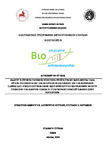| dc.creator | Giannoulis K.D., Evangelopoulos V., Gougoulias N., Wogiatzi E. | en |
| dc.date.accessioned | 2023-01-31T07:42:09Z | |
| dc.date.available | 2023-01-31T07:42:09Z | |
| dc.date.issued | 2020 | |
| dc.identifier | 10.1016/j.indcrop.2020.112611 | |
| dc.identifier.issn | 09266690 | |
| dc.identifier.uri | http://hdl.handle.net/11615/72361 | |
| dc.description.abstract | Soil-climatic conditions of Greece and Mediterranean basin in general are favor for the development of aromatic-medicinal plants. A great aromatic-medicinal plant that is cultivated on a large scale in Greece and in Mediterranean basin in general for its essential oil is lavender. Lavender organic cultivation is facing a serious problem with Rhizoctonia and Fusarium fungal infections resulting in the most cases to the destruction of the cultivation. The aim of the current study was to investigate the effect of bio-stimulators to flower and essential oil yield and its composition. For the purposes of the study field experiments were established in Microkastro Vojo Kozanis (40°14′44.25″N, 21°30′25.87″E) in 2018 and 2019, using a complete randomized experimental design. There was investigated the effect of different treatments (i). control, (ii). amalgerol 15000 mL ha−1, (iii). millerplex450 ml ha−1, (iv). sugarXpress 12000 mL ha−1, in three equal applications) on flower, essential oil yield and composition under five replicates. The results refer to the sixth and seventh lavender’ growing year. It was found that flower (spike) yield was decreased by 50% at the second experimentation year while the use of the bio-stimulators had a statistically significant effect compared with control, indicating their positive effect. In essential oil content case, amalgerol treatment was found to have the same content for both growing years. Finally, the identified essential oil components were 48, and there were found many differences to the composition between the tested treatments. © 2020 Elsevier B.V. | en |
| dc.language.iso | en | en |
| dc.source | Industrial Crops and Products | en |
| dc.source.uri | https://www.scopus.com/inward/record.uri?eid=2-s2.0-85086501054&doi=10.1016%2fj.indcrop.2020.112611&partnerID=40&md5=dfd3e4c8c247a7ca01cbf046f4ab6052 | |
| dc.subject | Aromatic compounds | en |
| dc.subject | Cultivation | en |
| dc.subject | Design of experiments | en |
| dc.subject | Plants (botany) | en |
| dc.subject | Climatic conditions | en |
| dc.subject | Different treatments | en |
| dc.subject | Essential oil components | en |
| dc.subject | Essential oil yields | en |
| dc.subject | Fungal infection | en |
| dc.subject | Lavandula angustifolia | en |
| dc.subject | Mediterranean basin | en |
| dc.subject | Organic cultivations | en |
| dc.subject | Essential oils | en |
| dc.subject | chemical composition | en |
| dc.subject | cultivation | en |
| dc.subject | essential oil | en |
| dc.subject | experimental design | en |
| dc.subject | flower | en |
| dc.subject | fungal disease | en |
| dc.subject | fungus | en |
| dc.subject | infectivity | en |
| dc.subject | medicinal plant | en |
| dc.subject | Greece | en |
| dc.subject | Mediterranean Sea | en |
| dc.subject | Fusarium | en |
| dc.subject | Lavandula | en |
| dc.subject | Lavandula angustifolia | en |
| dc.subject | Rhizoctonia | en |
| dc.subject | Elsevier B.V. | en |
| dc.title | Could bio-stimulators affect flower, essential oil yield, and its composition in organic lavender (Lavandula angustifolia) cultivation? | en |
| dc.type | journalArticle | en |


